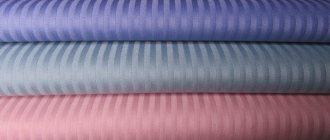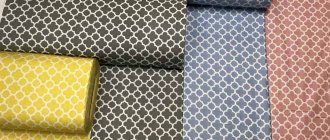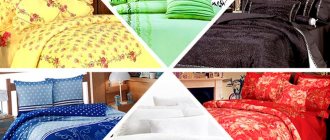Ironing is a long and labor-intensive process. Piles of crumpled bed and table linen can shock even an experienced housewife. I just want to delegate this boring task to someone else or even postpone it until later. However, knowing a few secrets of ironing sheets, tablecloths and duvet covers, you can significantly make your work easier, and if you try, you can turn this routine task into pleasure.
Do I need to iron bed linen?
From a medical point of view, ironing bed linen is simply necessary.
Whether it is necessary to iron bed linen is an individual question; each housewife decides for herself whether she needs to do such labor-intensive work or is it better to do something more interesting.
- In some homes, it is customary to simply carefully fold slightly damp sheets and duvet covers and dry them in the folded state, without further ironing. Proponents of this method of caring for bedding claim that after treatment with a hot iron, the material becomes less hygroscopic, that is, it does not absorb moisture well, and the product wears out faster.
- From a medical point of view, ironing bed linen is simply necessary, and children's sets must be subjected to heat treatment on both sides: from the face and from the back. Typically, cotton and linen sheets and pillowcases are ironed with an iron heated to a temperature of more than 100 ° C, which completely rids the products of harmful microorganisms. If you put things in a pile after they are poorly dried and not ironed, then pathogenic microflora, even fungus, can form on the surface of the material.
In addition, after ironing, the linen acquires a fresh smell, the material becomes softer and more pleasant, a smooth bed without folds or wrinkles looks neat and respectable.
“Ironing... Who would stroke me!”: 10 ways to simplify and speed up the ironing process by half
Why iron clothes if they don't meow? If this is not an argument for you, read our selection of tips that will simplify and speed up this tedious procedure several times.
Trick 1. The size of the board matters: the wider it is, the easier and faster the process goes.
The most common ironing board size is 37-38 cm. For example, these are the boards sold in Ikea. There are even narrower boards - 32-33 cm. These options come in handy when there is very little space in the apartment. And yet, even in this case, it is worth taking a wider board - from 45 centimeters. With it, in one “run” you can iron more, which means faster. For example, a children's or women's T-shirt on a wide board can be ironed in just one pass.
Trick 2. For the laziest
This life hack is suitable for bed linen, T-shirts, pants, jumpers, children's clothing and all those things that have a simple cut and do not require creases. Unfortunately, the trick won't work with viscose items.
- It's simple:
immediately after washing (!), take the damp items out of the washing machine and stack them on top of each other, and then leave it for an hour. After an hour, hang things as usual - you will see that things will look great.
Trick 3. The steam generator is better than a regular iron and steamer combined
The speed and ease of working with a steam generator is off the charts and cannot be compared with a conventional iron or steamer. With it you can iron both jeans and silk blouses without adjusting the temperature and risking burning the fabric. In addition, the steam generator is capable of ironing fabric folded in several layers (which significantly saves time and effort when ironing, say, bed linen).
For example, ironing 10 shirts, 13 children's T-shirts, 2 pairs of ribbed trousers and 5 adult T-shirts with a steam generator takes only 15 minutes including warming up. With a regular iron, you can spend at least an hour on so many things.
- A steamer is also good and can be an effective part of the system for some families. For example, it is ideal for ironing knitted items, synthetic materials, and jackets. But still, it cannot replace an iron, since it does not cope well with cotton and linen clothes/linen, your hand gets tired quickly with it, which means you won’t be able to do much ironing with it.
- Ideally, you should choose a professional tailor's steam generator. For example, Silter with a silicone removable sole. You can use tap water in it, as it has a self-cleaning function for descaling, and the device is relatively inexpensive, powerful and lightweight. Despite the fact that this steam generator is designed for the needs of a studio, it is also perfect for home use.
Trick 4. Don’t even try to iron the dry fabric.
Ironing completely dry clothes is a futile task, unless we are talking about non-capricious synthetic fabrics. Therefore, always dampen wrinkled items or use the steam function. This way the result will be better, and the process will go much faster. How to wet the cloth? To do this, you can spray the item, then fold it and let it sit for 5 minutes. The old proven method of ironing through damp gauze will also work.
Trick 5. Wash and dry things correctly
Many things don’t need to be ironed if you wash and hang them correctly.
- Washed items should be hung immediately and done carefully, straightening them out;
- To prevent wrinkles from dryer bars on T-shirts and other clothes, purchase a dryer with thick wires. For example, made of wood, like the Borstad series dryer from Ikea (see photo).
- When washing, add fabric softener to soften fabrics;
- Do not “overdry” things, try to iron them slightly damp (this will make things go much faster).
Trick 6. The dryer really changes your life
The trick is to pull out warm, dry clothes immediately after drying. Then you need to cool it in a smoothed form - on hangers or on a plane (you can on top of each other, the main thing is to straighten things out). That's all: 10-15 minutes and you don't need to iron anything, just put it in the closet.
Trick 7. If possible, use more technologically advanced boards and other devices
Today there are many devices for easy ironing in stores.











